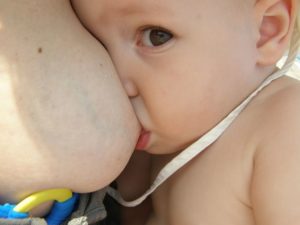Among all the questions mothers have about their babies’ arrival, some of the biggest are undoubtedly about breastfeeding. It’s no wonder, after all, it’s how your child will be fed, it creates a unique and wonderful bond between mother and baby, a moment of affection and love that offers a unique experience in a woman’s life1. With so many things to consider, of course, there are many doubts about breastfeeding. But one of the most relevant and also one of the most common is the question whether it’s normal for one breast to produce more milk than the other. Many mothers who go through this may feel worried, think that they’re having some kind of problem, or even that they’re breastfeeding incorrectly. But is that really the case?
Before talking about this, I have a suggestion for moms who are experiencing difficulties with breastfeeding: I recommend having a pre-consultation with a breastfeeding specialist to receive personalized and suitable guidance for you and your baby. Click here to learn more!
Is This Normal or Not?
To get started, let’s answer right away that yes, it is normal for one breast to produce more milk than the other. This can happen for a variety of reasons, among them the type of production that each breast has. No body is the same as another and every woman produces breast milk differently, and that doesn’t mean it’s better or worse in any way. There’s also the matter of the mother’s own control during breastfeeding. If she gives the right breast to the baby much more often, for example, that breast will naturally end up producing more milk. So, know that it’s normal for one breast to produce more milk than the other and this should not be a reason for concern at all for a mother.
How Does Breast Milk Production Work?
The hormone responsible for producing breast milk is prolactin2, which is produced by the woman’s body right after childbirth, in a region of the brain called the pituitary gland. Once this hormone is produced, the mammary lobules produce and store the milk. There is also another hormone in this process, oxytocin3, which is responsible for contracting the lobules and releasing this milk more naturally. The milk reaches the baby’s mouth through the lactiferous ducts, which form a kind of showerhead to the nipple. Oxytocin is usually released during breastfeeding, and that’s why while the child is feeding, mothers keep producing milk. 
How to Increase Breast Milk?
Now that you understand how breast milk is produced, it will be easier to understand what are the best ways to increase milk supply and why they work. We can highlight the main ways to increase breast milk:
- Drink Water
- Get Good Sleep
- Check Latching
- Have a Good Diet
- Wear Comfortable Clothes
Let’s talk in more detail about each of these tips to explain more precisely how each helps increase milk supply.
Drink Water
Staying hydrated is one of the most effective ways to naturally increase breast milk production. The baby doesn’t need water during the first 6 months of life because all the nutrients they need are in breast milk. About 87% of this milk is made up of water, so you can imagine the importance of staying hydrated, right?
Get Good Sleep
Being rested and having adequate sleep allows your body to work well so that the breastfeeding hormones function properly. In other words, having good nights of sleep directly helps with breast milk production.
Check Latching
If the baby isn’t latching correctly, you can develop problems such as cracked nipples, and it may also hinder milk production. The baby’s mouth should be around the entire areola, so they fill their mouth and are able to suck the milk in the best way.
Have a Good Diet
It’s not even necessary to explain why this is so important. If you produce all the necessary nutrients for your baby in the first months of life, it’s obvious that your diet should be healthy, avoiding very fatty foods and eating every 3 hours.
Wear Comfortable Clothes
Tight bras and shirts can end up inhibiting milk production. In addition, wearing more comfortable clothes also makes it easier when breastfeeding. In other words, light and loose clothing will make your life easier in many ways while you are breastfeeding.
When Should I Switch Breasts?
There are no strict rules or general recommendations for when to switch breasts during breastfeeding. Actually, you should find the way that works best for you and your baby. Some mothers report offering only one breast for a feeding session and only giving the other at the next session. Others prefer to alternate to balance the size of both breasts, since the amount the baby feeds influences this, and also to avoid one breast getting “overloaded” with milk, which can cause pain and discomfort. As we’ve mentioned earlier, you should find the best way for you. A way that won’t cause you pain, keeps the baby calm, and makes the breastfeeding moment as special as it should be between mother and baby. Even though there is a lot of concern, it’s normal for one breast to produce more milk than the other. It’s something that happens to many mothers and may bother some more than others. The truth is, in spite of everything, this will not directly interfere with breastfeeding or with your baby’s health, which is what matters most. So don’t worry, if this happens to you know that it’s very normal and there are simple and easy ways to solve the problem if you are very bothered. When the mother is calm and confident about breastfeeding, her connection with the baby during this special moment is even better and more enjoyable. See Also: Lose Weight While Breastfeeding and Learn How to Eat Better After Birth Photo: Irene











